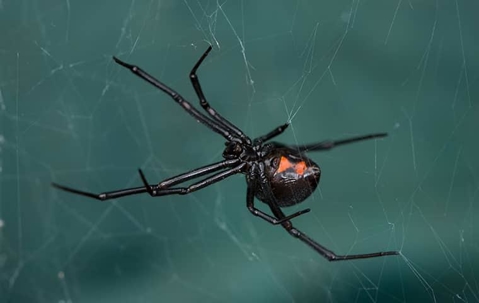How To Spot Black Widows
Most invasive spider varieties aren’t dangerous, but it’s important to be able to tell them apart from the more hazardous species out there. Not only that, but all spider populations are a sign of a larger pest problem since they hunt other bugs. Here’s how you can spot a black widow spider:
- Color: Black widows are jet black save for the red hourglass marking found on their bellies. This marking can be lighter or even brown in color, and developing widow spiders may only have a pair of dots on their bellies, rather than the full hourglass shape.
- Size: Black widows are typically larger than other house spiders, though they are still several hundred times smaller than a human. They typically grow to be around an inch in total body and leg span.
- Environment: Black widows prefer woody areas where they can hide during the day. Inspect these areas regularly for signs of spiders or webs.
Dangerous Bites & How To Handle Them
The thing that makes black widows so much scarier than other spider varieties is their venom, which they administer via bites. That said, black widow bites are rare. These docile and shy creatures tend to avoid people and only bite if provoked. If a bite occurs, however, you should seek medical attention immediately. These are common symptoms of black widow bites:
- Nausea: Our bodies’ natural reaction to being poisoned is to try and purge the venom from our systems. This will do nothing for spider venom in the bloodstream, however, and the nausea that can accompany a black widow bite only compounds this.
- Dizziness: As poison circulates in the bloodstream, people often experience high blood pressure accompanied by dizziness or lightheadedness.
- Spasms: Black widow venom is meant to paralyze their insect prey. While people are too large to be completely paralyzed by this poison, people do experience muscle spasms and tightness.
Spider Prevention
Spiders aren’t looking for food traces like other pests, meaning the only reason they are on your property is that other pests are already there. That’s why spider prevention is really about overall pest protection. Here are some steps you can take to reduce your risk of infestation:
- Crack sealing: Tiny bugs can make it through small openings in the walls or foundation, meaning you should regularly check for cracks or holes and make repairs where necessary.
- Food storage: Spiders don’t raid the pantry, but the critters they eat sure do. Storing food in sturdy containers will prevent pests from chewing through packaging and contaminating food, not to mention curb overall pest populations.
- Wood storage: Spiders specifically nest in woody environments, so it’s important to store wood piles or yard debris well away from any structures.
- Web sweeping: Whether you spot the spiders themselves or just their annoying webs, you can discourage them from continuing to lurk around by sweeping away or disrupting their webs.
Stay Safe With Professional Help
With black widow control, it’s better to play it safe. Rather than take on all the prevention steps necessary to keep spiders (and the pests they hunt) out of your home, turn instead to the advice and assistance of your local pest professionals. At Big D Pest & Termite Services, our staff can provide you with even more household pest prevention and control tips, not to mention a thorough inspection of your property. If problems are spotted, we’ll work with you to find the right solution -- one that solves the problem rather than covers it up or merely stalls it.
If spiders are a concern, contact Big D Pest & Termite Services right away for reliable home pest control in McKinney.

